The Intel Xeon W Review: W-2195, W-2155, W-2123, W-2104 and W-2102 Tested
by Ian Cutress & Joe Shields on July 30, 2018 1:00 PM EST- Posted in
- CPUs
- Intel
- Xeon
- Workstation
- ECC
- Skylake-SP
- Skylake-X
- Xeon-W
- Xeon Scalable
Test Bed and Setup
As per our processor testing policy, we take a premium category motherboard suitable for the socket, and equip the system with a suitable amount of memory running at the manufacturer's maximum supported frequency. This is also typically run at JEDEC subtimings where possible. It is noted that some users are not keen on this policy, stating that sometimes the maximum supported frequency is quite low, or faster memory is available at a similar price, or that the JEDEC speeds can be prohibitive for performance. While these comments make sense, ultimately very few users apply memory profiles (either XMP or other) as they require interaction with the BIOS, and most users will fall back on JEDEC supported speeds - this includes home users as well as industry who might want to shave off a cent or two from the cost or stay within the margins set by the manufacturer. Where possible, we will extend out testing to include faster memory modules either at the same time as the review or a later date.
| Test Setup | ||||||
| Processors | Xeon | W-2195 | W-2155 | W-2123 | W-2104 | W-2102 |
| Cores | 18C/36T | 10C/20T | 4C/8T | 4C/4T | 4C/4T | |
| Base | 2.3 GHz | 3.3 GHz | 3.6 GHz | 3.2 GHz | 2.9 GHz | |
| Turbo | 4.3 GHz | 4.5 GHz | 3.9 GHz | - | - | |
| Price | $2553 | $1440 | $294 | $255 | $202 | |
| Motherboard | Supermicro X11SRA (BIOS v1.10a) Spectre / Meltdown Patches Applied |
|||||
| Cooling | Corsair H115i | |||||
| Power Supply | Corsair HX750 | |||||
| Memory | Kingston 4x8GB DDR4 2666 CL19-19-19-443 RDIMM (KSM26RS8/8HAI) |
|||||
| Memory Settings | DDR4 2666 CL16-18-18-35 2T | |||||
| Video Cards | ASUS Strix GTX 980 | |||||
| Hard Drive | Crucial MX300 1TB | |||||
| Optical Drive | TSST TS-H653G | |||||
| Case | Open Test Bed | |||||
| Operating System | Windows 10 Pro 64-bit | |||||
Power Consumption
For our power consumption testing, we place the system under a heavy Prime95 load and then take the power consumption reading from the internal CPU sensor. This is the sensor that determines power resources on the system, as well as how fan speeds and throttling should be adjusted. On most platforms we get a breakdown of chip-wide power compared to core power and memory controller power, however the Skylake-SP platform has all that removed and we can only get full-chip power. We also test on a per-core level.
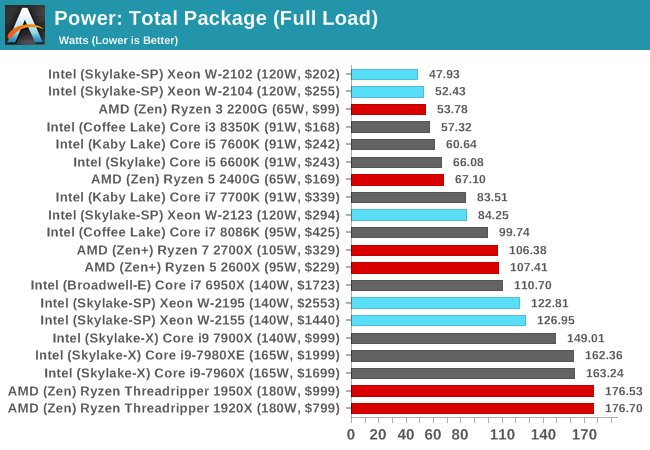
At full load, all of our Xeon W chips are underneath TDP, despite running at full core turbo. The Xeon W-2102 and Xeon W-2104 really show that these quad-core parts are certainly well below the 120W rating. When we look at the higher core count Xeon W parts, we see that the power consumption is well below the corresponding Core i9 processors - the Xeon W-2195 for example is only 123W, compared to 162W for the Core i9 version.
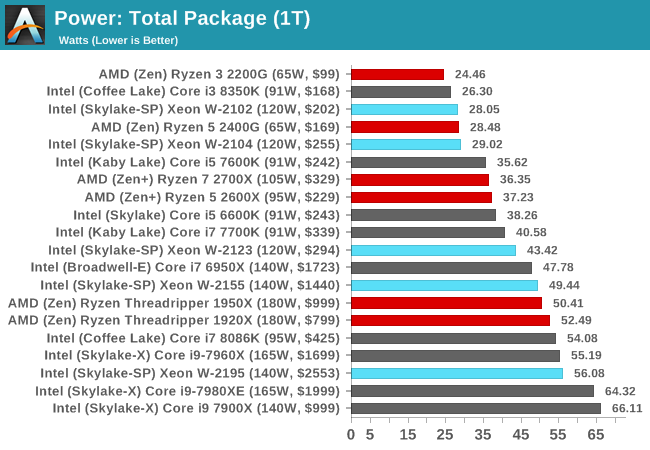
If we look at the chips when only a single thread is loaded, then the Xeon W chips spread out a bit more. The AMD parts fare better here compared to the W-2195, but the W-2195 is still below the Core i9 parts.
Many thanks to...
We must thank the following companies for kindly providing hardware for our multiple test beds. Some of this hardware is not in this testbed specifically but is used in other testing.
Thank you to ASUS for providing us with GTX 980 Strix GPUs. At the time of release, the STRIX brand from ASUS was aimed at silent running, or to use the marketing term: '0dB Silent Gaming'. This enables the card to disable the fans when the GPU is dealing with low loads well within temperature specifications. These cards equip the GTX 980 silicon with ASUS' Direct CU II cooler and 10-phase digital VRMs, aimed at high-efficiency conversion. Along with the card, ASUS bundles GPU Tweak software for overclocking and streaming assistance.
The GTX 980 uses NVIDIA's GM204 silicon die, built upon their Maxwell architecture. This die is 5.2 billion transistors for a die size of 298 mm2, built on TMSC's 28nm process. A GTX 980 uses the full GM204 core, with 2048 CUDA Cores and 64 ROPs with a 256-bit memory bus to GDDR5. The official power rating for the GTX 980 is 165W.
The ASUS GTX 980 Strix 4GB (or the full name of STRIX-GTX980-DC2OC-4GD5) runs a reasonable overclock over a reference GTX 980 card, with frequencies in the range of 1178-1279 MHz. The memory runs at stock, in this case, 7010 MHz. Video outputs include three DisplayPort connectors, one HDMI 2.0 connector, and a DVI-I.
Further Reading: AnandTech's NVIDIA GTX 980 Review
Thank you to Crucial for providing us with MX300 SSDs. Crucial stepped up to the plate as our benchmark list grows larger with newer benchmarks and titles, and the 1TB MX300 units are strong performers. Based on Marvell's 88SS1074 controller and using Micron's 384Gbit 32-layer 3D TLC NAND, these are 7mm high, 2.5-inch drives rated for 92K random read IOPS and 530/510 MB/s sequential read and write speeds.
The 1TB models we are using here support TCG Opal 2.0 and IEEE-1667 (eDrive) encryption and have a 360TB rated endurance with a three-year warranty.
Further Reading: AnandTech's Crucial MX300 (750 GB) Review
Thank you to Corsair for providing us with Vengeance LPX DDR4 Memory, HX750 Power Supply, and H115i CPU Cooler.
Corsair kindly sent a 4x8GB DDR4 2666 set of their Vengeance LPX low profile, high-performance memory for our stock testing. The heatsink is made of pure aluminum to help remove heat from the sticks and has an eight-layer PCB. The heatsink is a low profile design to help fit in spaces where there may not be room for a tall heat spreader; think a SFF case or using a large heatsink. Timings on this specific set come in at 16-18-18-35. The Vengeance LPX line supports XMP 2.0 profiles for easily setting the speed and timings. It also comes with a limited lifetime warranty.
Powering the test system is Corsair's HX750 Power Supply. This HX750 is a dual mode unit able to switch from a single 12V rail (62.5A/750W) to a five rail CPU (40A max ea.) and is also fully modular. It has a typical selection of connectors, including dual EPS 4+4 pin four PCIe connectors and a whopping 16 SATA power leads, as well as four 4-pin Molex connectors.
The 135mm fluid dynamic bearing fan remains off until it is 40% loaded offering complete silence in light workloads. The HX750 comes with a ten-year warranty.
In order to cool these high-TDP HEDT CPUs, Corsair sent over its latest and largest AIO in the H115i. This closed-loop system uses a 280mm radiator with 2x140mm SP140L PWM controlled fans. The pump/block combination mounts to all modern CPU sockets. Users are also able to integrate this cooler into the Corsair link software via USB for more control and options.
Thank You to Kingston for sampling us some DDR4-2666 C19 RDIMM Memory.
Xeon W processors support RDIMM ECC memory, and our motherboard here would not accept UDIMMs, and Kingston kindly supplied the memory needed. The (KSM26RS8/8HAI) modules were faultless in our testing.


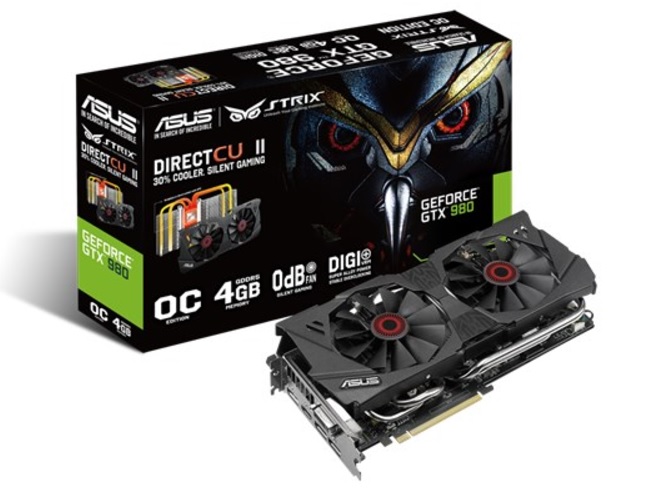

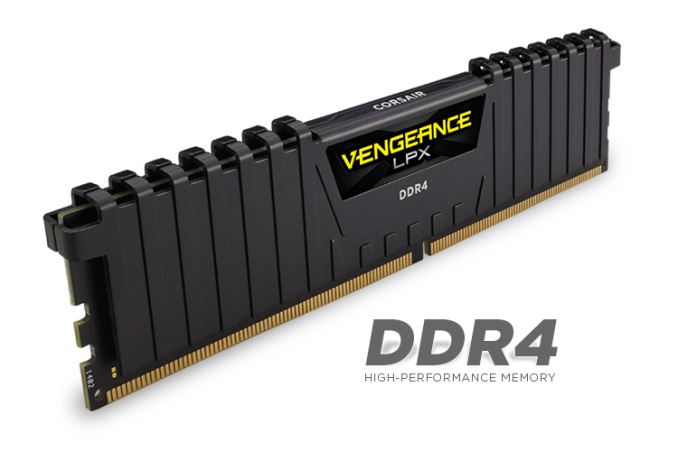
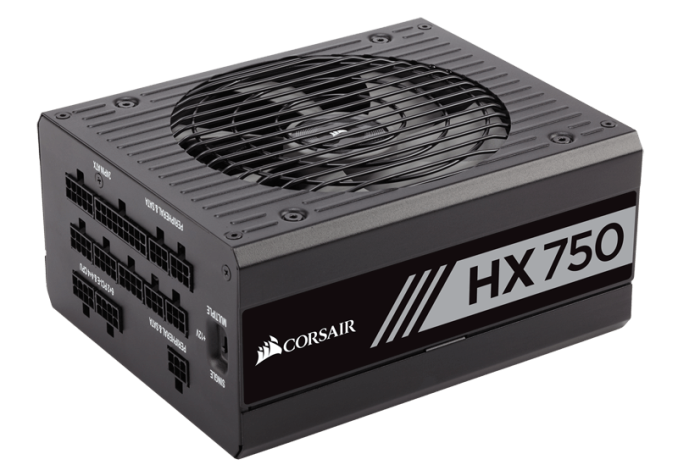
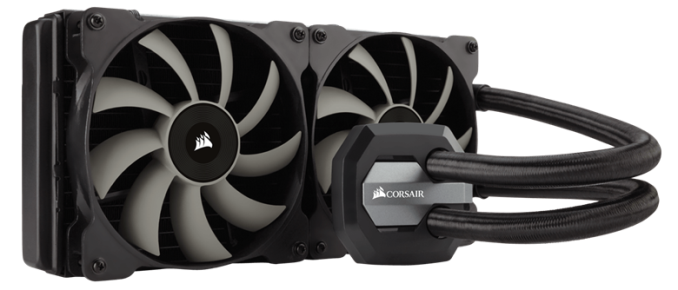
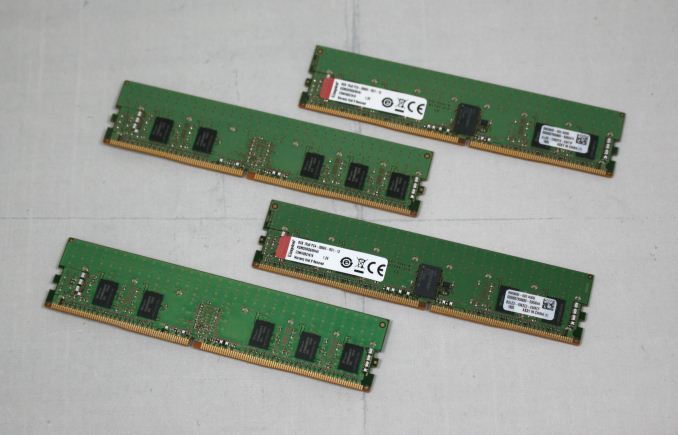








74 Comments
View All Comments
HStewart - Monday, July 30, 2018 - link
I am curious why Xeon W for same core count is typically slower than Core X - also I notice the Scalable CPU have much more functionally especially related to reliability. In essence to keep the system running 24/7. Also the Scalable CPU's also appear to have 6 channel memory instead of 4 Channel memory. I wonder when 6 channel memory comes to consumer level CPUs.One test that would be is to see what same core processor for Xeon W vs the Scalar CPU with only one CPU.
Another test that could be interesting is a dual CPU scalable with say 2 12 cores verses 1 24 core of CPU on same level.
Just test to see what it with more cores vs CPU's
duploxxx - Monday, July 30, 2018 - link
one threadripper 2.0 and you can throw all intel configs here into the bintricomp - Monday, July 30, 2018 - link
YeaHHStewart - Monday, July 30, 2018 - link
I wish people keep the topic to the subject and not blab about competitor productsduploxxx - Tuesday, July 31, 2018 - link
if you would know anything about cpu scalable systems you would not ask these questions. a 2*12 vs 1*24 will be roughly 20% slower if your application scales cross the total core count due to in between socket communication. Even Intel provides data sheets on that. No need to test.as long as intel can screw consumers they will not invest anything, you wont get 6 mem lanes in xeon W or consumer unless competition does it and they get nailed. btw why on earth would you need that on a consumer platform?
BurntMyBacon - Tuesday, July 31, 2018 - link
If all things are equal, then what you say is true. There is a known performance drop due to intersocket communications. However, you may have more TDP headroom (depends on the chips you are using) and mostly likely more effective cooling with two sockets allowing for higher frequencies with the same number of active cores. If the workload doesn't require an abundance of socket to socket communications, then it is conceivable that the two socket solution may have merit is such circumstances.SanX - Tuesday, July 31, 2018 - link
Why ARM is just digging its buggers watching the game where it can beat Intel ? Where are ARM server and supercomputer chips? ARM processors soon surpass Intel in transistor count. And for the same amount of transistors ARM is 50-100x cheaper then duopoly Intel/AMD. As an additional advantage for ARM these two segments will soon completely abandon Microsoft.beggerking@yahoo.com - Thursday, August 2, 2018 - link
ARM is RISC which is completely from CISC so applications and os are limited. Microsoft server os has really evolved in every aspect in the last few years that may take RISC years to catch up on the software side.JoJ - Saturday, August 4, 2018 - link
ARM is Fujitsu's choice of successor core to SPARC64+, a architecture Fujitsu invested decades of research and development and testing to offer both commercially and at a national laboratory supercomputing level. ARM is therefore not a knee jerk choice of direction for a very interesting super builder.Obviously you exaggerated a little bit, saying ARM is "50 - 100 times cheaper than AMD/Intel".
I wish I could shake my belief that pedantic literalism in Internet forums in general wasn't preventing broad discussion - we exaggerate in real life without any socially degrading effects, why not online?
OR ate your conversation parties sniffing that obviously -- any person who inadvertently speaks technically inaccurately despite forming perfectly understandable inquiry... as if they are unwashed know nothings, and turning on their heels to end the discussion.....a bit like HN's "we don't tolerate humor here" reactions to innocent attempts at lightening the thread...
but I digress, my point here is your comment above raised a couple of interesting questions, that I feel haven't been answered only because I think readers by themselves first over react to hyperbole, then infil the accepted wisdom to answer your questions, despite you ask about pertinent value critical concerns. I feel that by supplying the answer and dismissing the comment as uninformed, the most important thing happening is the reader voluntarily self reinforcing given marketing positions, and not engaging with the subject at all. I work in advertisingand am actually studying this, because advertising buyers adore this kind of"mind share" but we think that is at odds with the advertising buyers wanting"open minded, engaging, adaptable, innovative" customers.
1. have a look at Serve The Homes review of the Cavium ARM server generations. This architecture is definitely viable and competitive now in a increasing number of application areas.
2. Microsoft Azure has ARM deployed in my estimation at scale second only to Baidu. I am tempted to think it's actually politics that prevents a ARM Azure server machine offering to commercial users, little else. The problem with Microsoft, is user expectation of a all round performance consistency and intel and Microsoft have been working on that smooth delivery for decades.
3. ARM is bit cheaper if you need to do more than a quick recompile with a few architecture options selected.
re when we will see a Azure ARM instance, I think could even be waiting for the ability for Cavium to actually deliver hardware, because unmet demand is a fatal blow to new technology, as well as successful realisation.
All my"quality time" with our server fleet, is spent all hands on the thermal and power profiles of our applications.
We will rewrite to gain fractions of a percentage point where it's a consistent number across runs. Since twenty five years ago, I crashed a colo cage by not considering the power on start surge of a huge half terabyte raid array, power loads obsessed me. Power usage in Cavium ARM looks like a winner for us.
4. BUT I said that,based on data mapping dense thermal sensor arrays, with the functional code paths of the actual application logic in flight across the fleet, at the time. If we're able to calculate the cost benefit of routing a new application function to a specific server, depending on the thermal load and core behaviour at the time of dispatch, I admit we're not very typical for a small scale customer. I think small is a server count below 10,000 here, including any peak on demand usage in case you're consumer retail and sell half price Gucci shoes on Black Monday.
(we got surprised by the reliability of gains from very crude information. Originally we just wanted to see if we could balance the flows in the hot aisle, and even throttle hotspot buildup if we lost some cooling locally. For Intel, we got lots of gains, by sending jobs to not exceed the optimal max turbo clock of a processor, and immediately filling out the slower cores with background chores. AMD and Cavium ARM are not as sophisticated about thermal management, where Intel is keen on overkill recently, eg four nigh identical Xeon Gold SKUs. Just do really read that STH review about this"redundancy of the Xeon processor parts- I came away with a purchase order for the reviewed SKU, because we're so excited about the power management system roles in production deployment, as a competitive advantage.
5. REAL COST ADVANTAGE DEPENDS ON CHANNEL PENETRATION, WITH AMD AT 2%, yes, TWO percent is considered healthy for them today, AMD need to be shipping in far greater volume, to move the money dial to realise the kind of cost advantage SanX is excited about.
Certification of countless applications is hardly begun...
I want to use a ARM workstation, to eat my dog food. This necessitates nvidia Quadro cards support. Yes, I write for a living. I target CUDA for a ever increasing proportion of customer needs. SURE I can just remote machines at will. BUT IF YOU DON'T GIVE CRITICAL DEVELOPERS TRULY GREAT HARDWARE, YOU'RE ABANDONING THE PLATFORM FOR ANY IDEA OF GENERAL DEPLOYMENT.
6. Probably the last sentence should have been standalone here.
I'll just say that we need a workstation as cool as the Silicon Graphics Indy of'93, to get a chance of getting a new GENERAL purpose platform in the mainstream soon.
7. I am constantly a both astounded by the simple fact that we have a chip that good to compete at all, yet scared because I am starting to wonder if we'll ever see sales above"bargaining power level" and platform insurance, and the niche market for companies able to extract whole value chains from controling their entire software ecosystem, something almost nobody in the real world can do.
JoJ - Saturday, August 4, 2018 - link
typo, mea,in point 3, I mean to say, "ARM is NOT cheaper, if you need to do more than a quick recompile.."